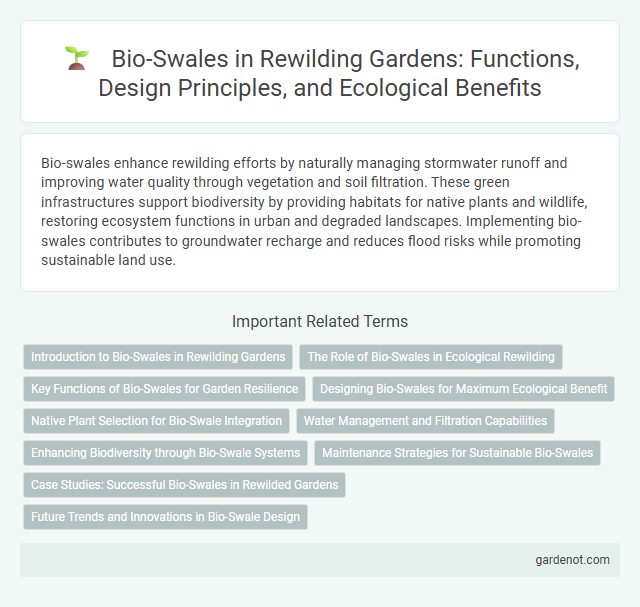Bio-swales enhance rewilding efforts by naturally managing stormwater runoff and improving water quality through vegetation and soil filtration. These green infrastructures support biodiversity by providing habitats for native plants and wildlife, restoring ecosystem functions in urban and degraded landscapes. Implementing bio-swales contributes to groundwater recharge and reduces flood risks while promoting sustainable land use.
Introduction to Bio-Swales in Rewilding Gardens
Bio-swales in rewilding gardens serve as natural water management systems designed to capture, filter, and slowly release stormwater, reducing runoff and improving groundwater recharge. These vegetated channels use native plants and engineered soil layers to absorb pollutants and create habitats for local wildlife, enhancing biodiversity. Integrating bio-swales promotes sustainable ecosystem functions by mimicking natural hydrological processes within urban and rehabilitated landscapes.
The Role of Bio-Swales in Ecological Rewilding
Bio-swales play a crucial role in ecological rewilding by naturally managing stormwater runoff through vegetation and soil filtration, reducing pollution and preventing erosion. These green infrastructure elements support local biodiversity by creating habitats for native plants and wildlife while enhancing groundwater recharge. Integrating bio-swales into urban and rewilded landscapes promotes sustainable water cycles and fosters resilient ecosystems.
Key Functions of Bio-Swales for Garden Resilience
Bio-swales play a crucial role in enhancing garden resilience by efficiently managing stormwater runoff through natural filtration and absorption processes. They reduce soil erosion and prevent nutrient runoff by slowing water flow, allowing sediments and pollutants to settle before entering waterways. Incorporating native plants in bio-swales also boosts biodiversity, improves soil health, and supports habitat creation for beneficial insects and pollinators.
Designing Bio-Swales for Maximum Ecological Benefit
Designing bio-swales for maximum ecological benefit involves incorporating native plant species that enhance water filtration and provide habitat for local wildlife. Strategic shaping of the swale maximizes stormwater retention while preventing erosion, promoting groundwater recharge. Integrating diverse vegetation layers supports pollinators and increases biodiversity, making bio-swales effective tools for sustainable urban water management.
Native Plant Selection for Bio-Swale Integration
Selecting native plants for bio-swale integration enhances stormwater management by promoting efficient water absorption and filtration. Native species such as carex, swamp milkweed, and blue flag iris provide deep root systems that stabilize soil and reduce erosion, supporting native biodiversity. Incorporating region-specific flora ensures resilience to local climate conditions and minimizes maintenance requirements, contributing to sustainable rewilding efforts.
Water Management and Filtration Capabilities
Bio-swales significantly enhance water management by directing stormwater runoff through vegetated, shallow channels that slow and filter the flow. Their natural filtration capabilities trap sediments, nutrients, and pollutants, improving water quality before it recharges groundwater or enters waterways. Integrating bio-swales in rewilding projects promotes sustainable hydrology and restores aquatic ecosystems.
Enhancing Biodiversity through Bio-Swale Systems
Bio-swale systems significantly enhance biodiversity by creating microhabitats that support diverse plant and animal species within urban landscapes. These engineered landscapes use native vegetation to filter stormwater, promote pollinator activity, and provide shelter for amphibians, birds, and beneficial insects. Integrating bio-swales into urban planning strengthens ecological networks and fosters resilient, sustainable ecosystems.
Maintenance Strategies for Sustainable Bio-Swales
Effective maintenance strategies for sustainable bio-swales include regular inspection to prevent clogging, periodic removal of sediment and debris, and monitoring plant health to ensure optimal filtration and water absorption. Incorporating adaptive vegetation management with native, drought-resistant species reduces water consumption and promotes biodiversity. Implementing scheduled inspections and sustainable irrigation practices enhances long-term bio-swale functionality and environmental benefits.
Case Studies: Successful Bio-Swales in Rewilded Gardens
Case studies of successful bio-swales in rewilded gardens demonstrate significant improvements in stormwater management and biodiversity enhancement. Projects like the Seattle Arboretum and Brooklyn Grange Rooftop Garden showcase how bio-swales effectively filter pollutants, reduce runoff, and provide habitats for native flora and fauna. These examples highlight the crucial role of bio-swales in integrating ecological restoration within urban rewilding efforts.
Future Trends and Innovations in Bio-Swale Design
Future trends in bio-swale design emphasize integrating smart sensors for real-time water quality monitoring and automated irrigation systems to enhance stormwater management efficiency. Innovations include the use of native plant species engineered for higher pollutant absorption and the incorporation of modular, prefabricated bio-swale units for rapid urban deployment. These advancements aim to improve ecological benefits, reduce maintenance costs, and support sustainable urban water infrastructure.
Bio-swale Infographic

 gardenot.com
gardenot.com